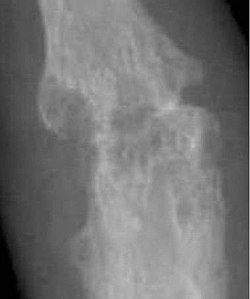| Arthropathy | |
|---|---|
| Other names | Joint disease |
 | |
| Bone erosions from rheumatoid arthritis. [1] | |
| Specialty | Rheumatology |
| Arthropathy | |
|---|---|
| Other names | Joint disease |
 | |
| Bone erosions from rheumatoid arthritis. [1] | |
| Specialty | Rheumatology |
Arthritis is a form of arthropathy that involves inflammation of one or more joints, [3] [4] while the term arthropathy may be used regardless of whether there is inflammation or not.
Joint diseases can be classified as follows:[ citation needed ]
Spondylarthropathy is any form of arthropathy of the vertebral column.[ citation needed ]
Joint pain is a common but non-specific sign of joint disease. Signs will depend on the specific disease, and may even then vary. Common signs may include:[ citation needed ]
Diagnosis may be a combination of medical history, physical examination, blood tests and medical imaging (generally X-ray initially).[ citation needed ]
| | This section is empty. You can help by adding to it. (June 2022) |